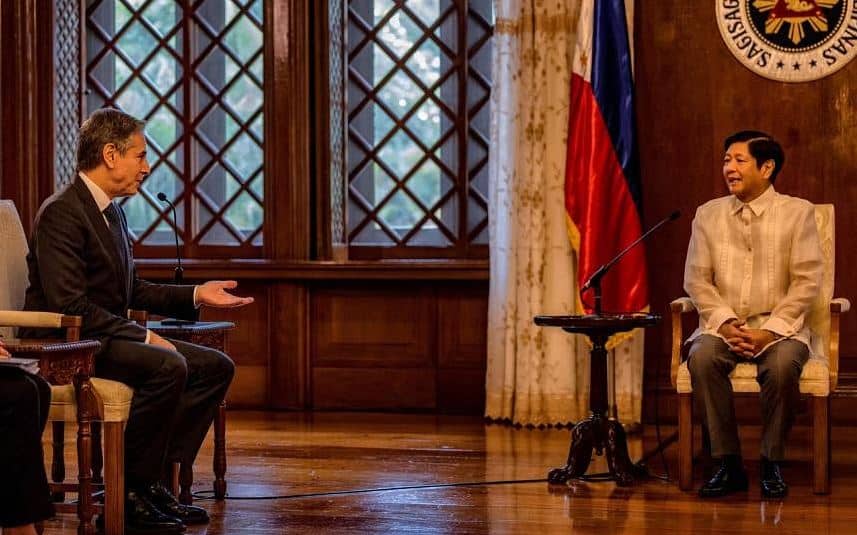
When the last US troops left the Philippines in the early 1990s, the prevailing assumption was that an extremely close military relationship between Washington and Manila would be just another relic of the Cold War. The decision by the Philippines Senate not to renew the US leases on Clark Air Base and Subic Bay Naval Base was quite emphatic. A thick layer of ash from the eruption of Mount Pinatubo made Clark unusable in any case, and public opinion in the country tended to both installations as a lingering, painful reminder of Washington’s colonial rule.
The mutual defense treaty remained intact, however, and US military and political officials soon sought to exploit Manila’s worries about the People’s Republic of China (PRC) to orchestrate a return of US forces. In particular, the Philippines’ government was deeply concerned about Beijing’s expansive territorial claims in the South China Sea – a stance that directly challenged Manila’s own claims. There were no longer any official US bases in the Philippines, but following the 9-11 terrorist attacks, George W. Bush’s administration responded favorably to Manila’s request to send a small contingent of troops – ostensibly to aid efforts to suppress militant Islamic rebels in the country’s southern islands. During Barack Obama’s administration, additional US military personnel began to return as part of Washington’s policy pivot to East Asia. They were given expanded access to bases that Manila controlled.
A new bilateral agreement now accelerates that process and substantially expands the scope of the US military presence. In April, the government of President Ferdinand Marcos Jr. announced that American forces would be stationed at four new locations. The official cover story is that the units would be available for disaster relief, but the underlying purpose is a more robust presence directed against the PRC. That point became quite clear later in April when US and Philippines forces conducted a military exercise involving more than 12,000 US troops.
The gradual return of Washington’s forces has coincided with a marked increase in US naval patrols of the South China Sea. That move was designed in part to show strong support for Manila’s territorial claims in that body of water, much to Beijing’s growing anger. Washington’s supportive stance took place, even though the government of Rodrigo Duterte seemed to take special pleasure in antagonizing US leaders, including by periodically threatening to end the alliance with the United States and adopt a pro-PRC stance.
Duterte’s loose cannon behavior did not diminish Washington’s military backing for the Philippines, and his threat ultimately proved to be hollow. Indeed, bilateral defense cooperation actually increased in July 2021 under a renewed visiting forces agreement. Military collaboration now appears to be on an especially fast track under Marcos’s friendlier administration.
Even during the tense days dealing with Duterte, Washington’s armed support for Manila regarding its territorial disputes with China did not falter. The United States ostentatiously backed Manila’s territorial claims when a confrontation between the Philippines and China broke out in March 2021 over the growing presence of PRC “fishing vessels” near the disputed Whitson Reef. The Biden administration promptly injected itself into the dispute. Secretary of State Antony Blinken emphatically took Manila’s side in a statement on Twitter. “The United States stands with our ally, the Philippines, in the face of the PRC’s maritime militia amassing at Whitson Reef,” he stated.
US leaders increasingly seem to regard the Philippines as another component in an overall containment policy directed against China. Using Manila as a pawn in that strategy, though, has multiple undesirable features. It is extremely confrontational toward the PRC at a time when there is a surplus of dangerous issues, especially Taiwan, already riling Washington’s relations with Beijing. China’s government has expressed pointed warnings about enhanced US military access to bases in the Philippines. Washington’s stance threatens to entangle the United States in parochial territorial spats that have little intrinsic relevance to America’s security and well-being. No rational American should want to risk a war with the PRC over Whitson Reef or similar meager stakes.
Instead of continuing to boost US military cooperation with Manila, US leaders need to reverse the growing troop presence. Indeed, they need to reassess the wisdom of the mutual defense treaty itself. The current situation is a classic case of an unwise, unnecessary, and potentially very dangerous entanglement on behalf of a minor foreign client. There are more than enough tripwires for the United States around the world without maintaining this one.
Reprinted with permission from Antiwar.com.

